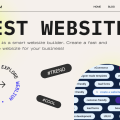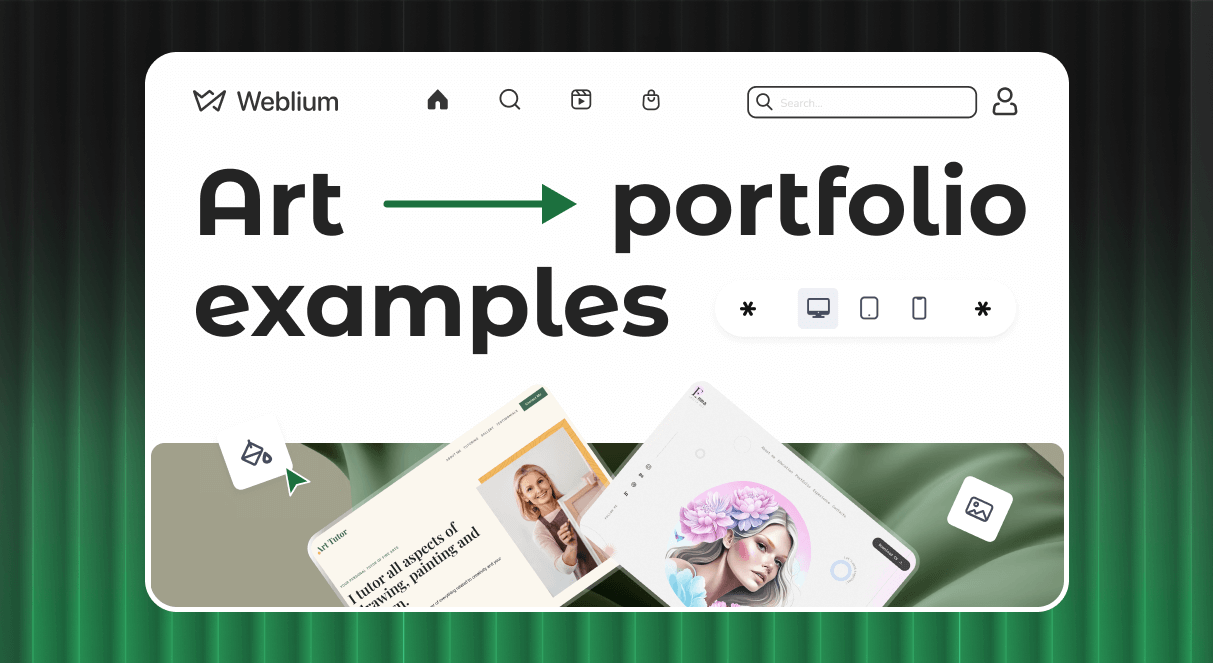
Best Art Portfolio Examples In 2025
An art portfolio is essential for showcasing your creative work, whether for galleries, clients, or online sales. Here are 20 inspiring artist websites that showcase diverse styles and creative approaches. Each example highlights unique elements that you can draw inspiration from for your own website.
By using the intuitive builder Weblium, you can efficiently create an impressive, functional art portfolio tailored to your goals and audience. Get started today to share your creativity with the world!
Contents
Art Tutor

This template stands out from other art portfolio examples, including all you need to present yourself as an artist. The About Me section is a perfect way to tell visitors about your story, background, experiences, etc. You can arrange services with the pre-built blocks, adding icons or images.
To display workshops or drawings, you can use sliders with photos, titles, and descriptions about each one. If you need to show a pricing list, you can add buttons to make bookings quick for clients.
The gallery is the main section, so you can choose your best pictures with the option to click on each and display it on full screen. It is a great idea to place testimonials right before the contact form so that when visitors make a decision, they can connect with you. If you like this template and are ready to fill it with your info, just click and go to the editor!

Online CVs are becoming more and more popular, and having one increases your chances of finding exciting opportunities. This template has a modern and engaging web design. There is a header with main sections and links to other platforms on the left. Even the button Write Me stands out with its style.
All specializations are added as slides, capturing users’ attention. Potential clients can conveniently find out about your bio, achievements, experience, and work. A good idea is to add not only feedback but also logos of brands you work with.
You can use a blog to post your insights, news, and thoughts. One of the outstanding features is the option to download a CV with one click. If you need to create an online portfolio, you can start with this template or any other art portfolio examples from the Weblium collection.
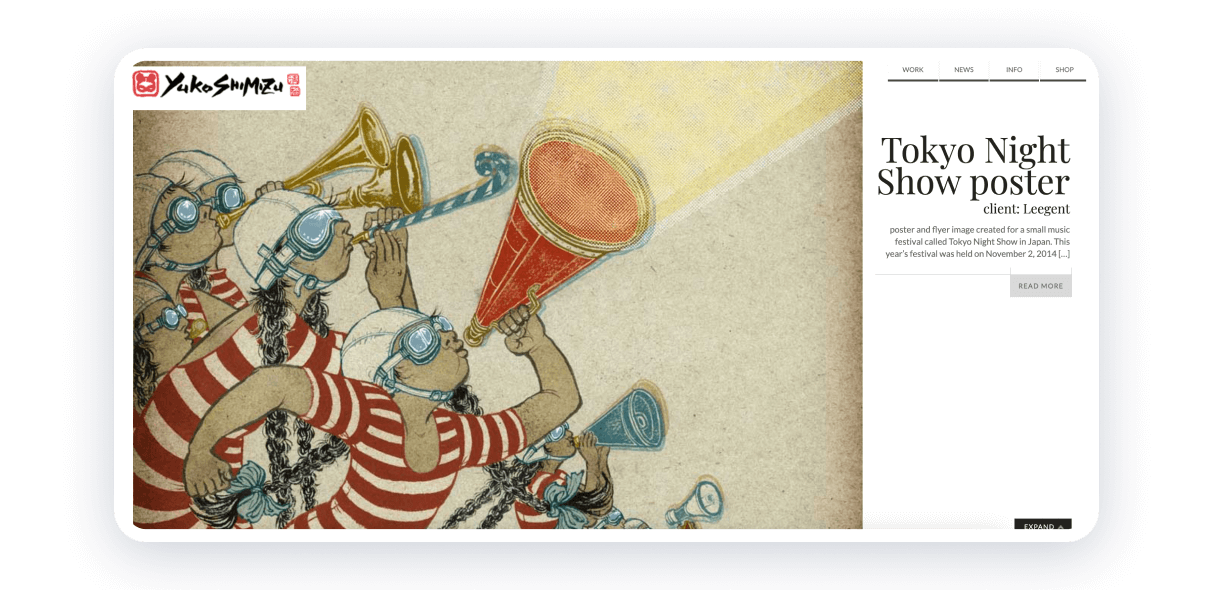
This artist portfolio website displays one selected image with a title and a short description on the homepage. Also, there are pages for Works, News, Info, and Shop. Each has its subpages. For example, News includes Events, a Blog, Updates, and Press, while Info consists of About, FAQ, and Contact. The FAQ section includes such information as advice for young illustrators, education, techniques, and more.
The website styles are basic: a white background, gray buttons, and dark fonts, so all the attention of users is drawn to the pictures.
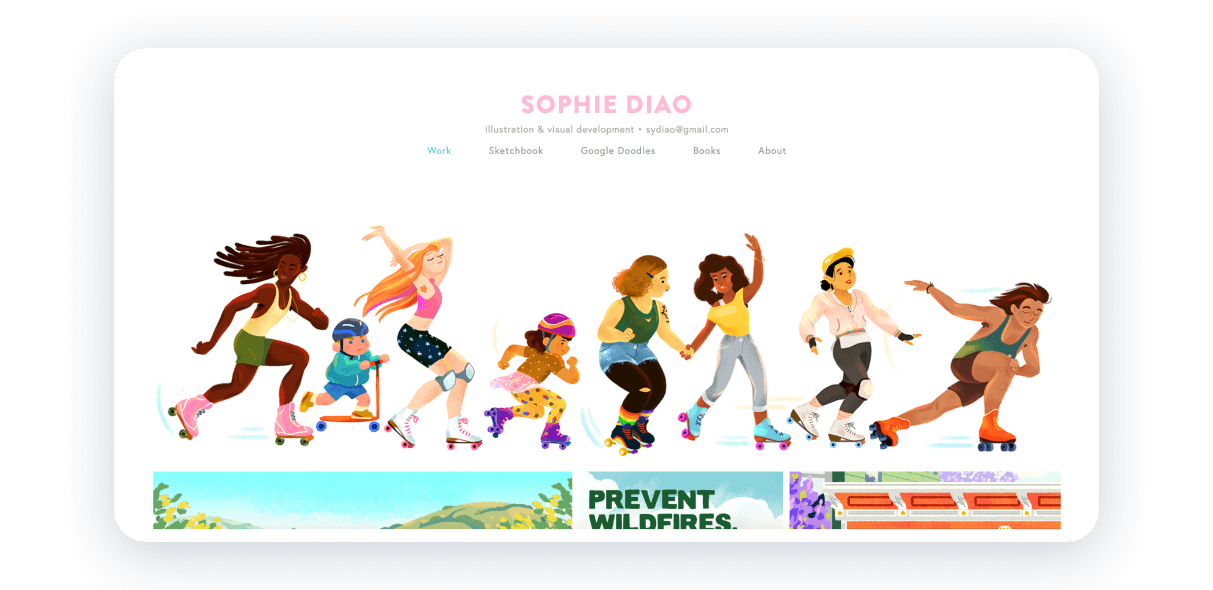
This website is adorable and represents the visuals of the artist. The tiny but clear header allows visitors to go through sections quickly. The Book page includes the main info about publishings and how users can buy them.
There are also videos showing Sophie’s animations with a YouTube player. Social links engage users to follow her on different platforms.
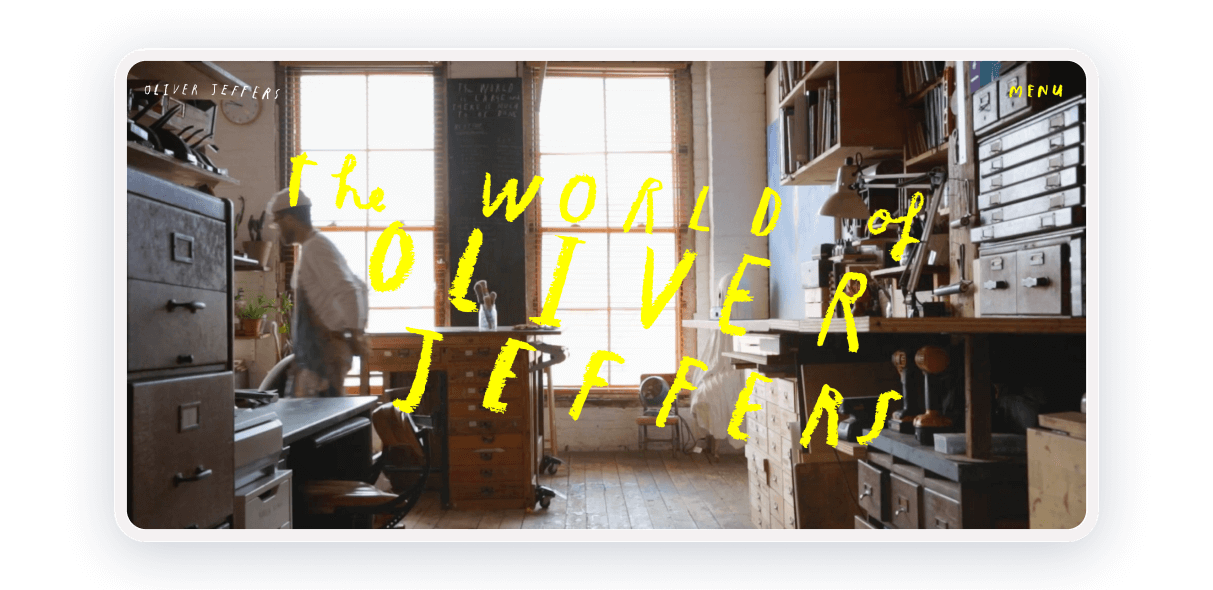
Here is a creative example of an artist’s website, starting with fonts and various video backgrounds. Oliver offers to find out his art, books, news, and objects.
For each product, there is a page with all the details and options to buy. After adding to the cart, there is a convenient way to check out orders. On Weblium, you can also connect various payment methods, such as PayPal, Stripe, and Square.
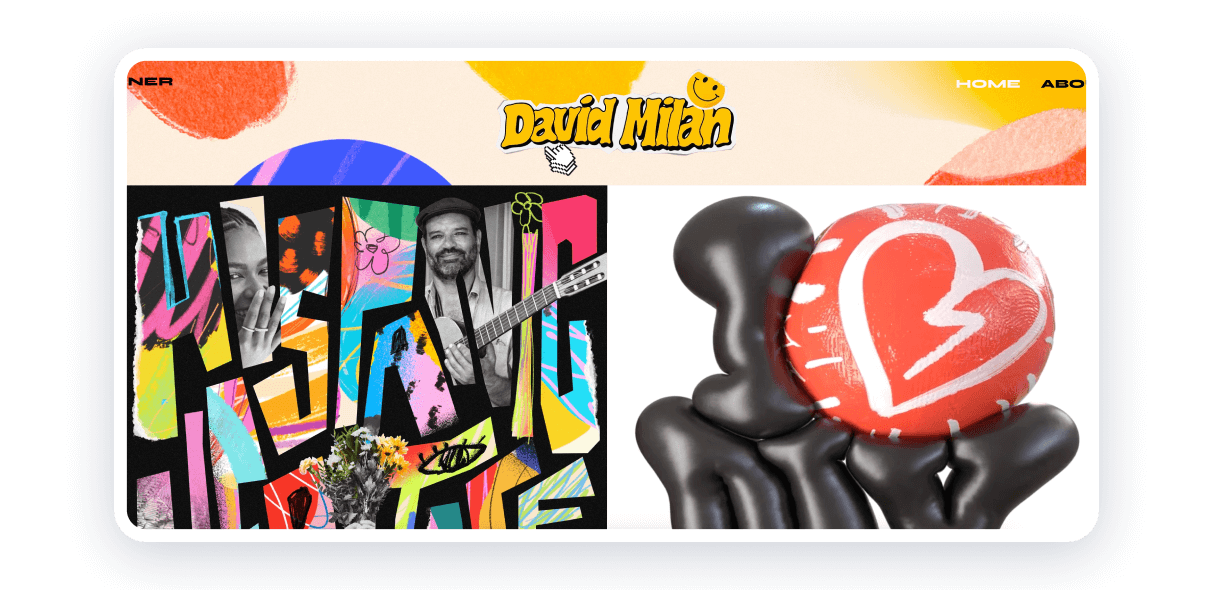
This website is full with many various artworks, styles, and colors. All of them are placed on the main page, loading while users scroll, ensuring a smooth experience. This feature makes this web page more like a portfolio.
David also shares brief information about himself and contacts for those who want to connect with him. It is a good idea for those who want their works to speak for them.
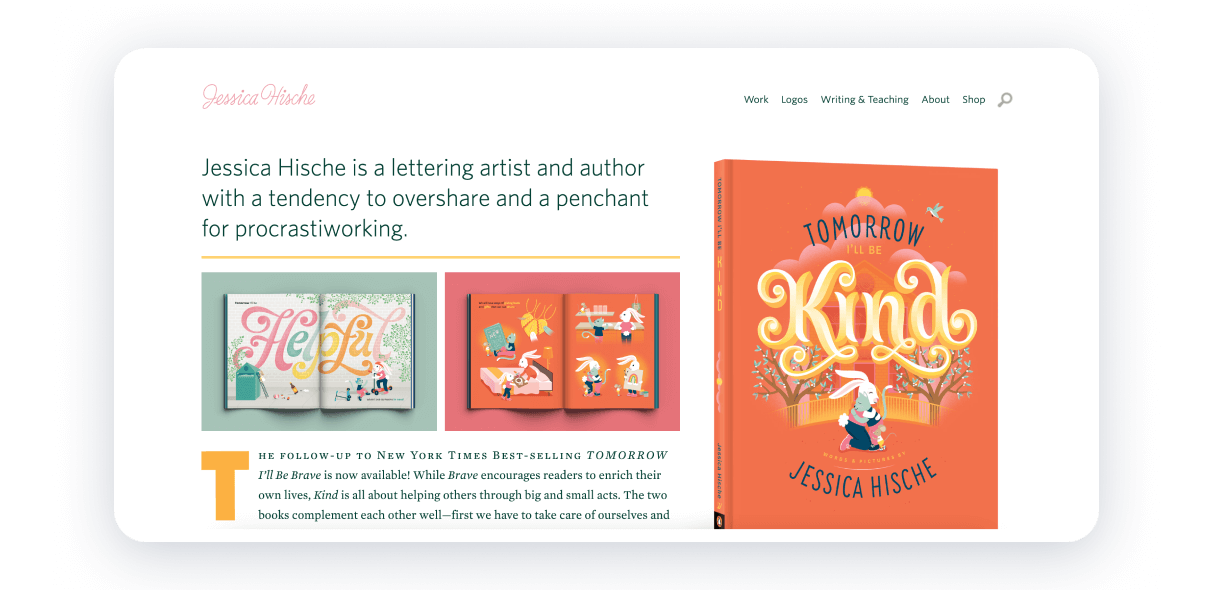
Jessica’s website demonstrates her latest book on the homepage with a short description, images, and a call to action to order. A great idea is to put quoted reviews about her book by famous people and also put a button to purchase.
All works are divided into categories, like advertising, books, editorials, etc. A particular page is used for logos, being the main part of her expertise.
The social links are placed not on the bottom of pages but in the middle so visitors can find them quicker. There is also an option to have a newsletter in a few clicks.
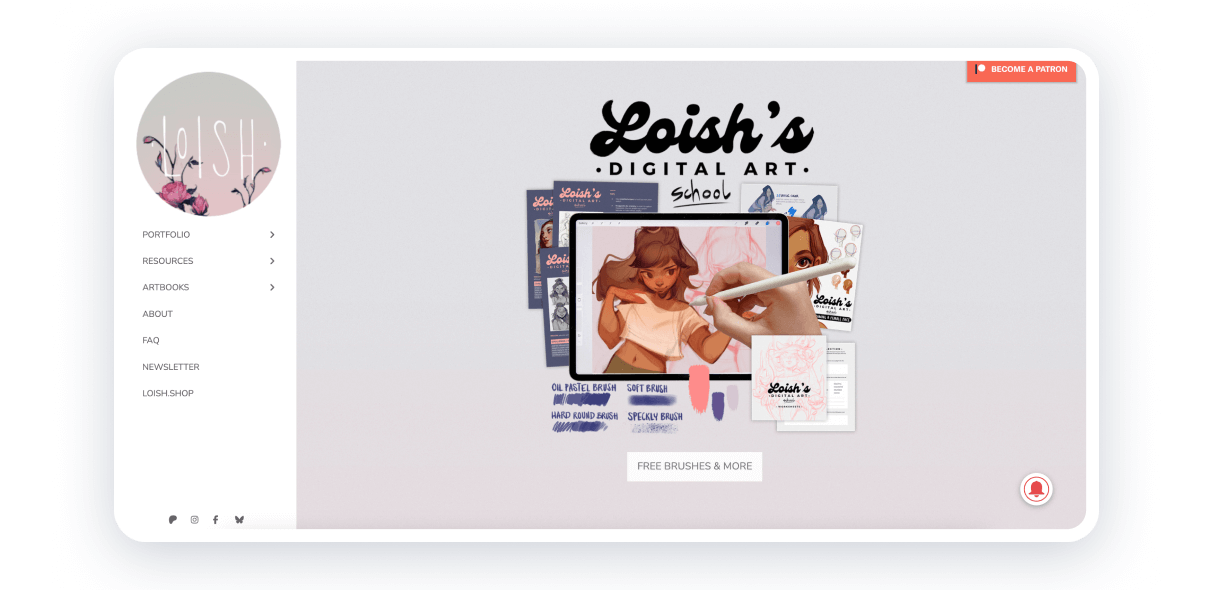
The website comes with an interactive slider on the homepage showing various types of art by Loish. Users can go to her digital paints, sign up for a newsletter, see sketches, or even access free brushes. There is also a Patreon button for support.
A portfolio itself is well-organized and sorted by topics. The FAQ section includes not only answers to questions but also a search option. The About page briefly introduces the artist with images and information.
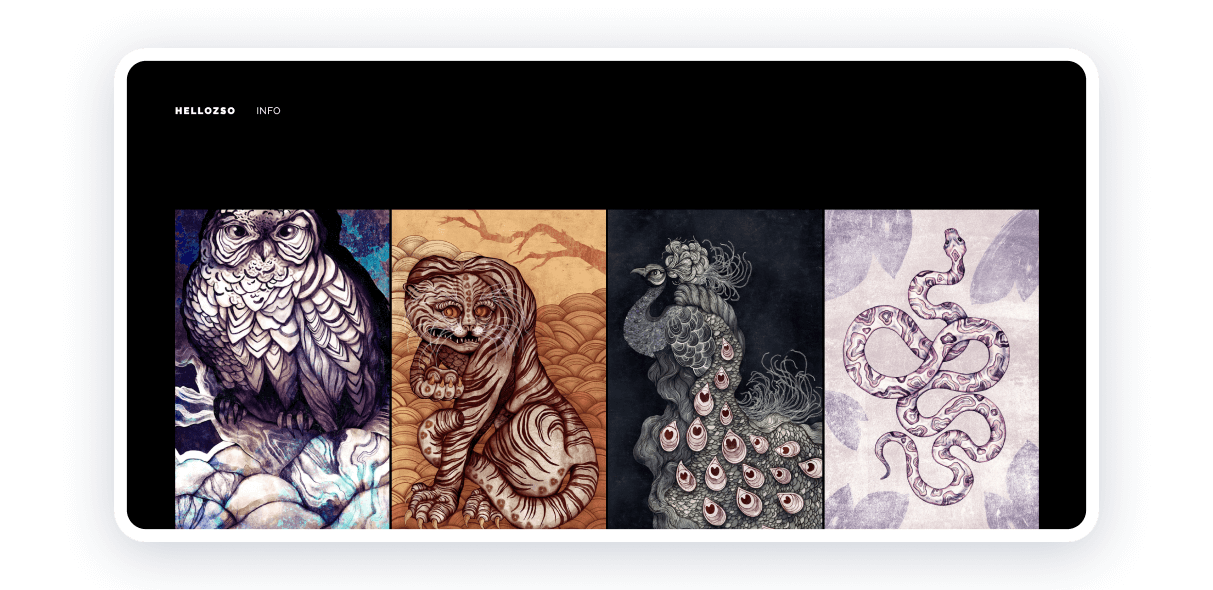
Finally, the pure yet eye-capturing portfolio of artwork, among other art portfolio examples. The stylish dark background perfectly emphasizes the uniqueness and brightness of the works.
The info section includes ways of communication, work experience, and social links. Nothing extra, just art!
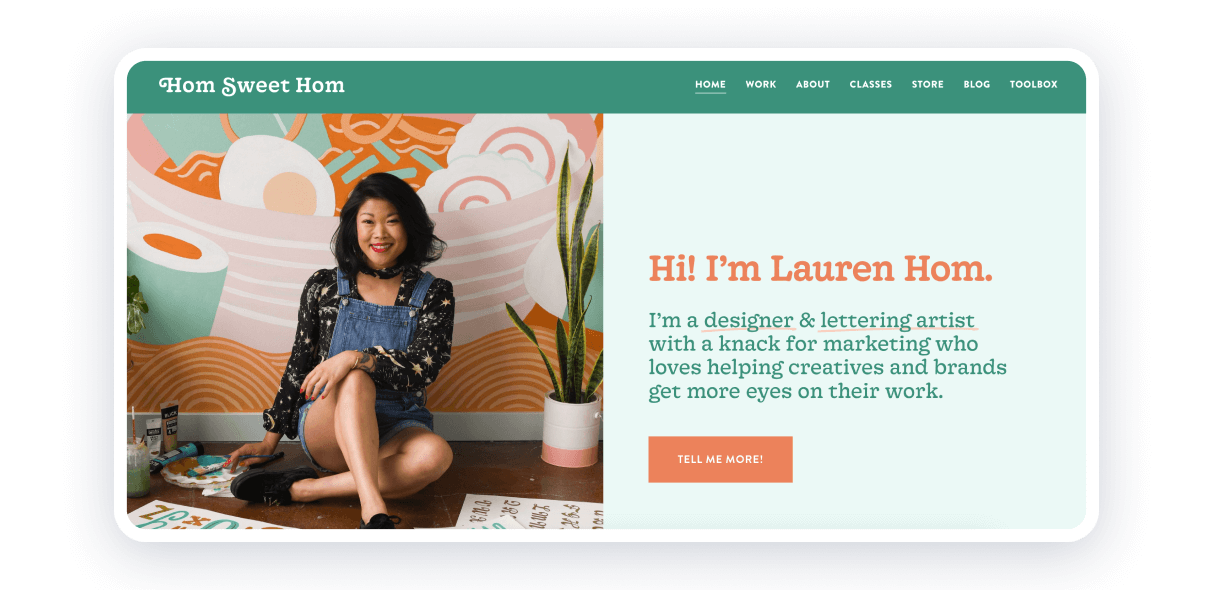
Here is the recipe for an excellent web design: pick two matching colors (here are green and orange), and use them for text blocks, buttons, and any other elements you want to highlight. If you have a logo, it is better to use the same colors and lines.
Then, you can introduce yourself like Lauren and tell about your specialization. Place your best works and leave a button to view more. A blog is one more ingredient to come closer to your audience.
Offer classes? Add all of them to one page and place a button for visitors to explore more. Once clicked, they can find out detailed information about each one and book their place.
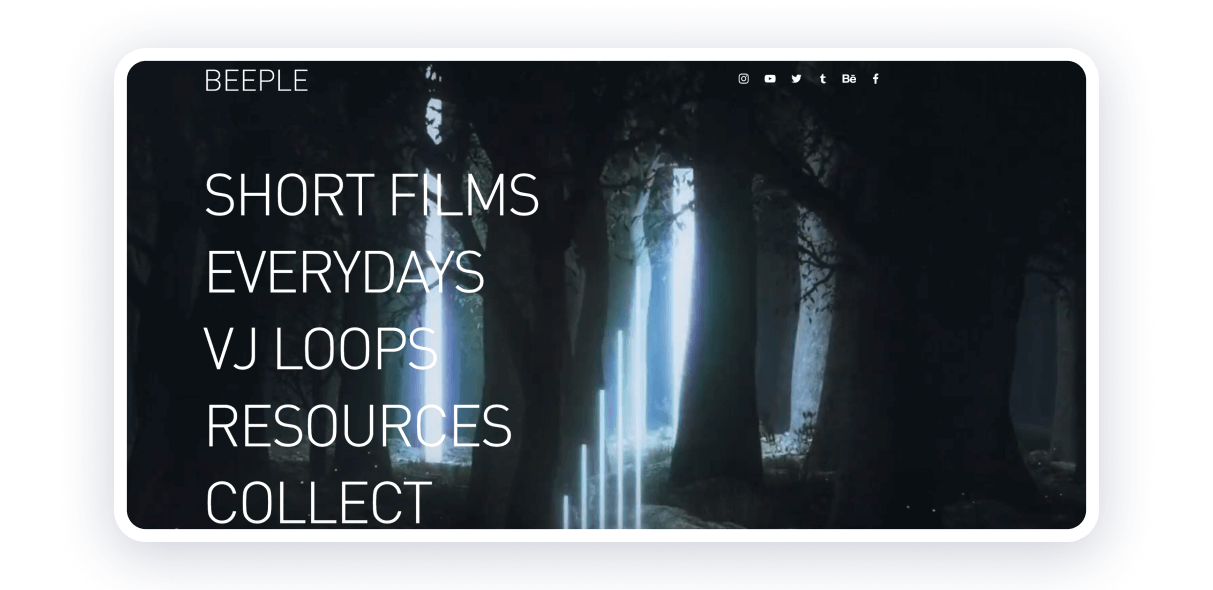
Welcome to the one-page website just for a quick introduction and a list of links. Potential clients can find your website across the internet and view all the platforms you use, click on those they use, and explore your works.
For example, if you want to present your videos and use YouTube for business, it’s a perfect way to boost visibility. If you are a student in college or university, you can use this kind of portfolio as the welcoming page for your project.
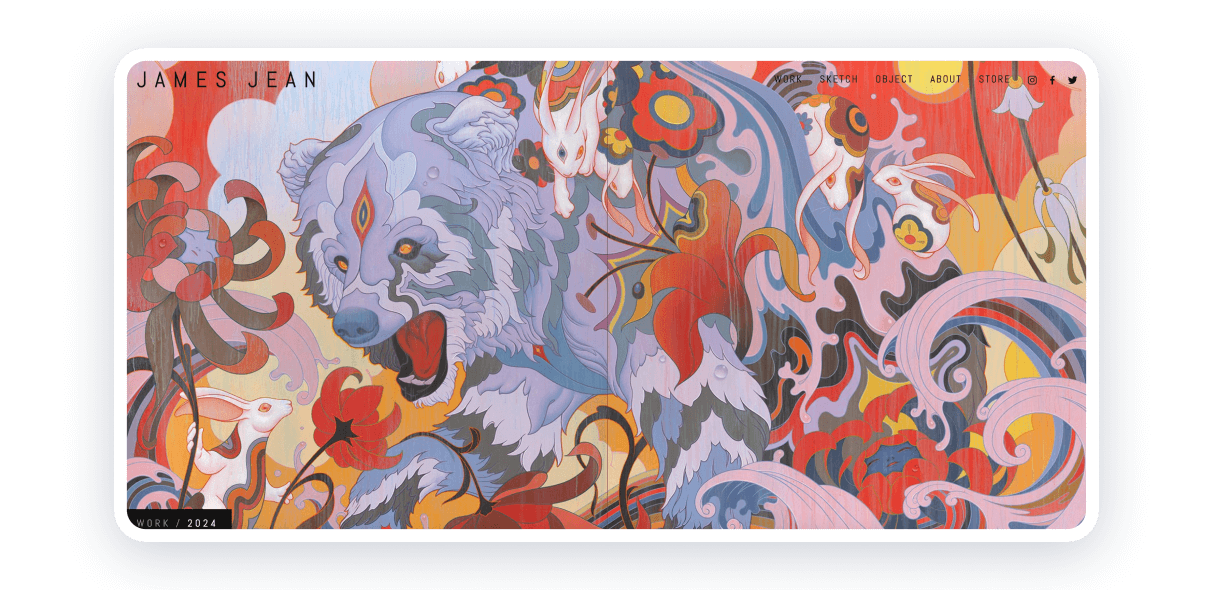
On the main page, there is only a slider with selected works, and from the header, users can go to work, sketch, object, or store. All are organized by year. The website also uses a pop-up window to invite visitors to join the mailing list for the latest updates.
The store includes all the main steps of ordering: catalog and product page with a few photos, price, info, and even videos. The cart allows buyers to pick up the payment method. Taxes and shipping are calculated on the checkout page. It is easy to set up a store in Weblium, and to connect various payment methods.
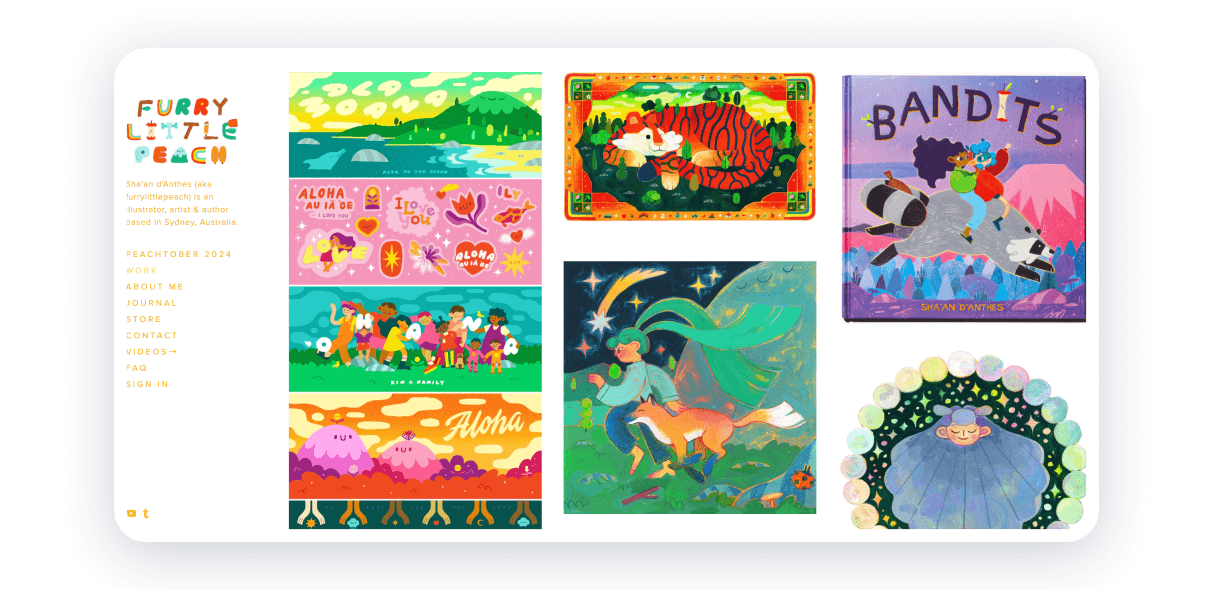
Probably the cutest art portfolio website in this list. The sticky navigation menu is placed on the left, giving users an option to scroll the gallery but quickly go to another page or section whenever they are ready.
The store is available only with a drop, but its page includes a message about this and media links for updates. So, when products become in stock, potential buyers can immediately come back to the website and order.
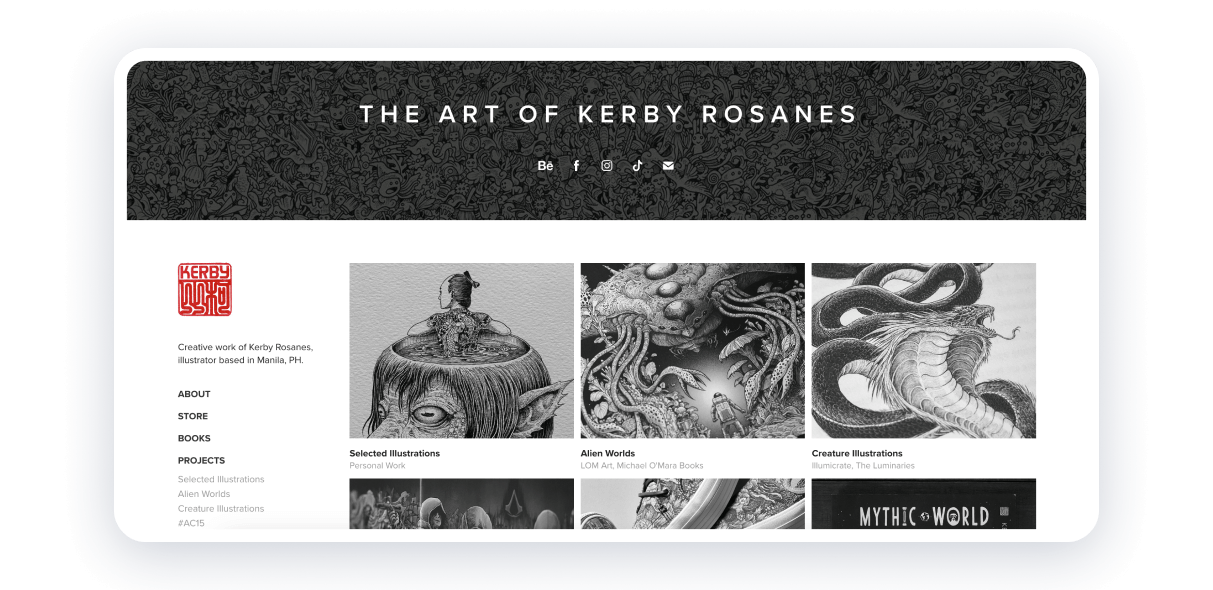
Here is an excellent one of black-and-white artist portfolio examples. All images on the main page are clickable because it’s a thumbnail for each collection. It simplifies user experience and makes all selected works to be seen.
The About page includes information on exhibitions, workshops, conferences, etc. The store also is structured by the type of products: digital files, clothing, prints, and an archive page.
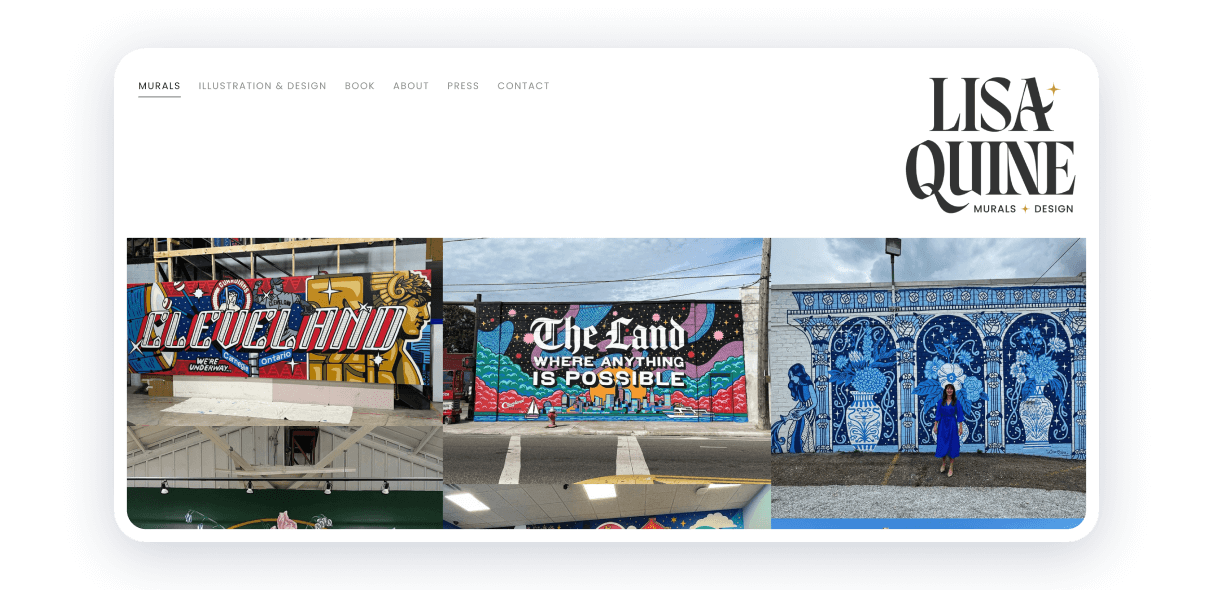
Lisa is a muralist and illustrator, and her website has a dedicated page for each area so everyone will find what they need. There is also a Press page with her articles and a Contact page with a clear form for inquiries.
For convenience, the mobile version header consists only of a one-word menu, clicking on which users have access to all the page links. All of Weblium’s websites have mobile adaptation, but you can also adjust it by yourself if you have an idea in mind.
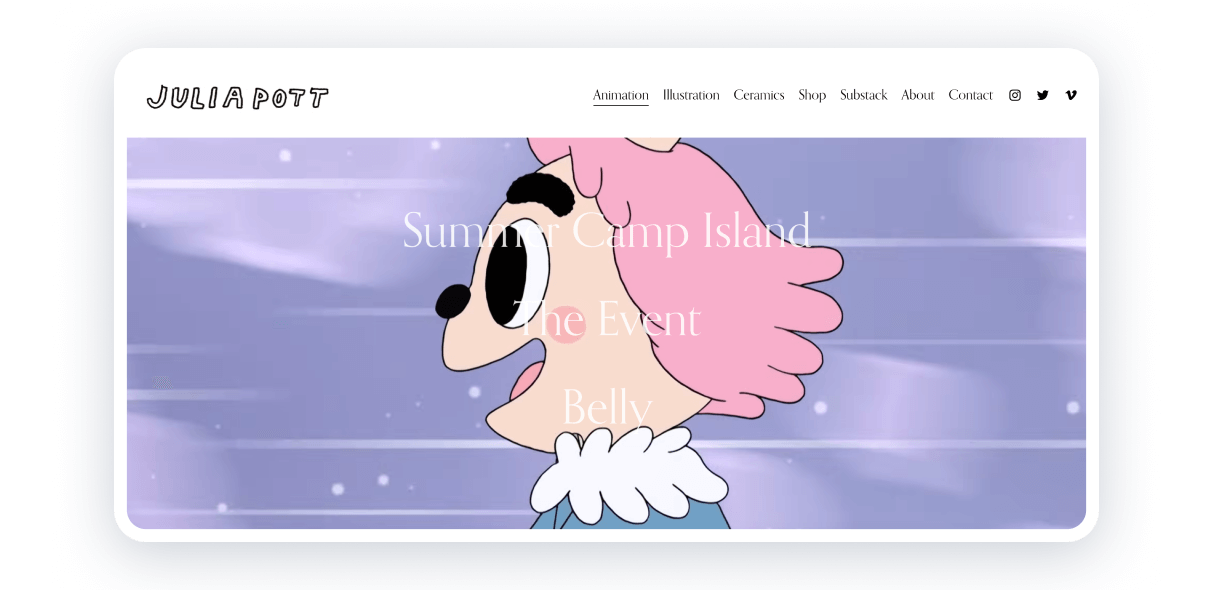
Julia is an animator and illustrator, so on the main page, there is a short video sample. Users can click and view her other animations. It is a great web design to stand out from video artist portfolio examples.
There is also a page for illustrations and ceramics. Visitors can go to the shop page and buy items. On the checkout page, there is an option to add a code for a discount. You can also offer your clients a promotion code. It is easy to set up in the Weblium editor.
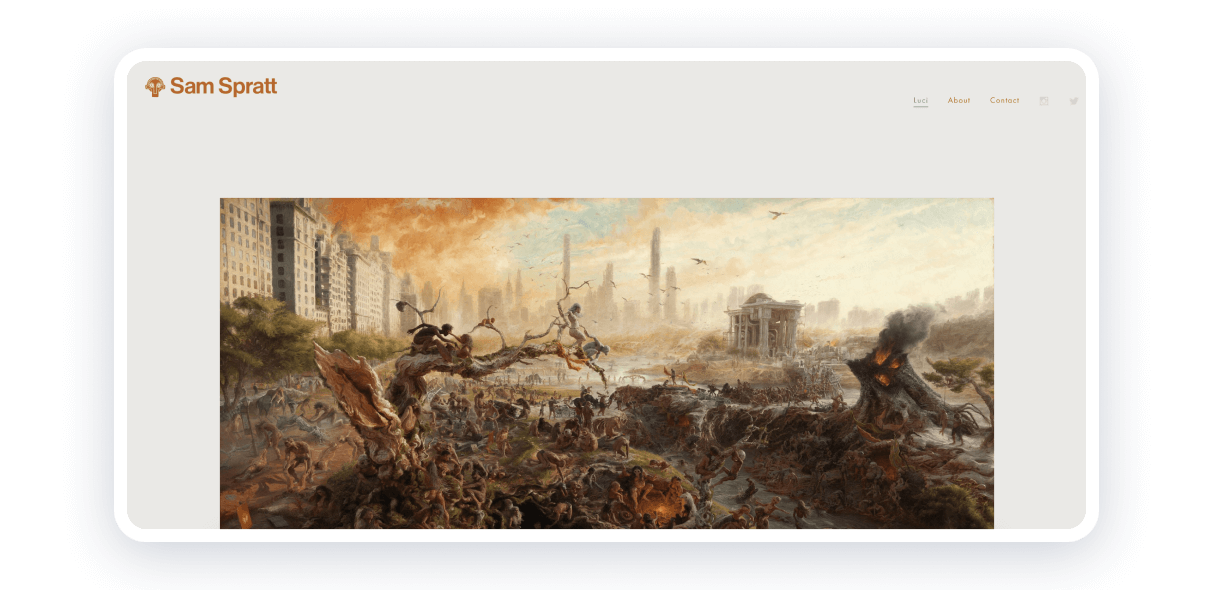
This is an outstanding example of showing works. Firstly, the main page consists of various sections. Users begin their journey with nine works from the latest series of digital paintings, Luci. To present and promote it, there is an overview section, the story and purpose, and exhibitions.
On the About page, Sam Spratt tells about himself and displays his client list. To contact the painter, visitors can write via email or fill out the form.
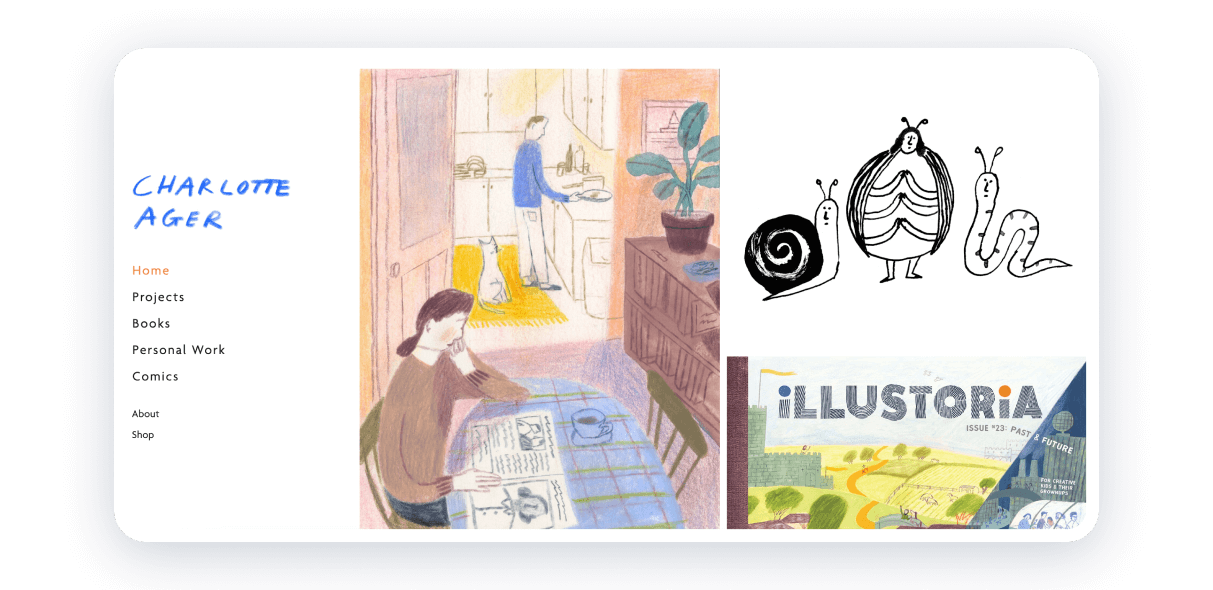
This art portfolio website includes a Projets page with various works organized by theme. Users can click on each and take a detailed look at the drawings. Besides this, Charlotte offers to pay attention to her pictures in books and comics, as well as personal work. On the About page, she mentions about her residences and lecturing.
It stands out from the list of art portfolio examples with its navigation menu, displaying pages for works with larger font sizes. The About and Shop page links are smaller, being the additional options on this website.
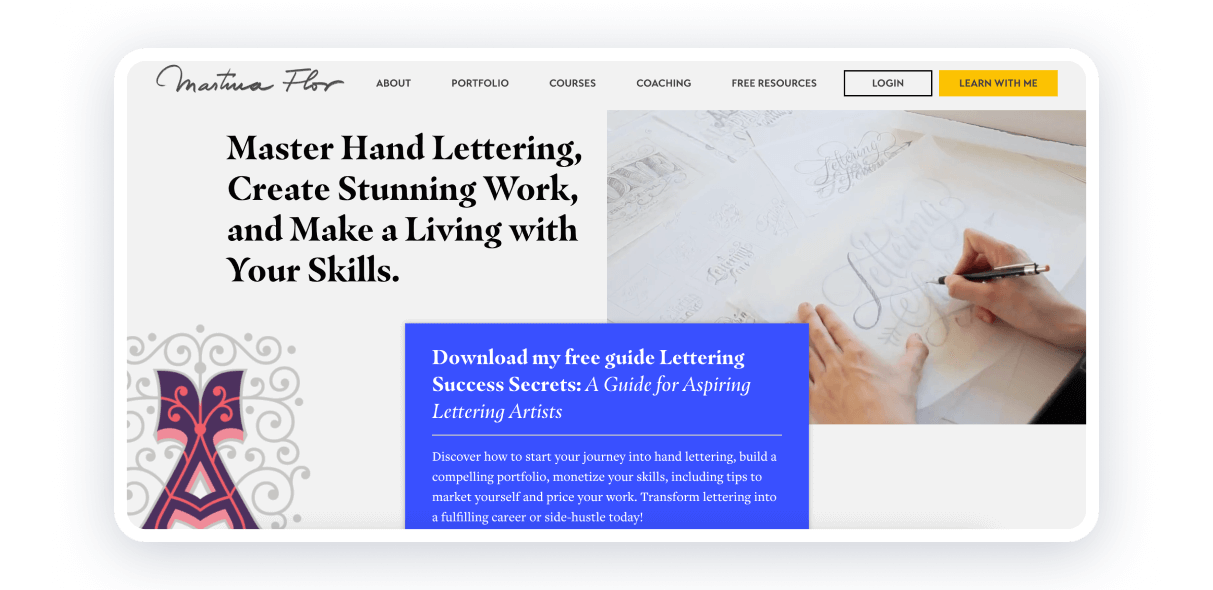
Right from the start, Martina offers visitors to fill in their email and get a free guide with a pop-up window. Here, the main page consists of brief info on each of her services. Users can get a copy of her book, find out about how to study with her, learn about her course and membership, read testimonials, etc.
The portfolio includes selected pictures, illustrations, publishings, advertising and more. For students, there is an option to download PDF files with tips and advice in a few clicks.
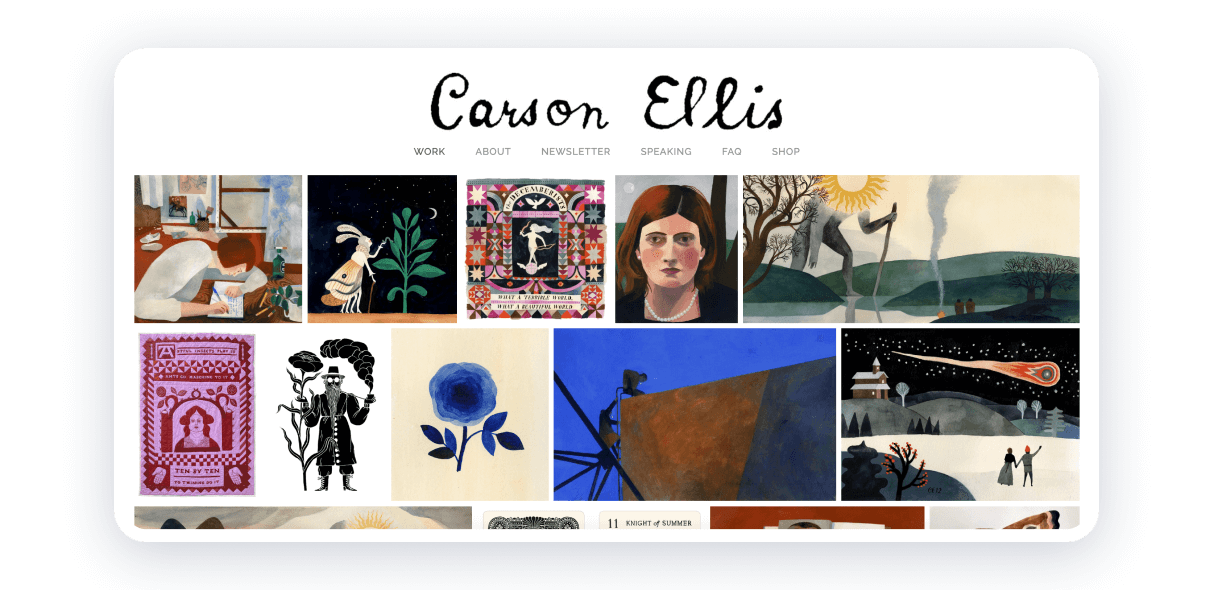
Let’s end this list of examples of art portfolios with a pixel-perfect design that shows selected work on the homepage. The About page includes not only information but also a CV, an Instagram link, and signing up for a newsletter.
If you are open to new opportunities, you can use the example of the Speaking page from this art portfolio website. It shows that Carson is available for engagements and workshops. All users need to do is contact her by email or phone. The FAQ page consists of important questions about materials, education, projects, etc.
How to make an art portfolio?
Here’s a simple guide to creating an art portfolio with ease and efficiency.
- Determine the purpose of your portfolio
Before starting, clarify the goal of your portfolio. For galleries, highlight your best work and organize it into cohesive series to reflect your artistic vision. If you aim to reach more clients, show diverse projects that demonstrate your versatility and ability to meet various creative needs. Online sales focus on clear, appealing images with descriptions and prices, integrating e-commerce functionality.
- Choose the right platform
Selecting the right builder is crucial for creating a portfolio that is both professional and easy to manage. Weblium stands out as a reliable option because it’s user-friendly, even for beginners. The platform offers beautiful templates tailored to artists and creatives. You get access to mobile-friendly designs, ensuring a polished look across all devices.
- Use Weblium templates for a professional look
Weblium provides a variety of templates specifically designed for artists. You can choose one that aligns with your artistic style, such as a minimalist gallery for fine artists or a bold, colorful layout for illustrators. Then, add your logo, select your preferred fonts and colors, and upload high-quality images of your work.
- Optimize for speed and device compatibility
A slow-loading or poorly displayed portfolio can drive away potential clients or buyers. Weblium’s websites are optimized to deliver quick page loads and are automatically mobile-friendly.
What should an art portfolio include?
To make your portfolio practical and appealing to clients, galleries, or potential buyers, it should include the following key elements:
- A brief introduction of yourself as an artist
Provide a glimpse into your background, artistic journey, and inspirations. Highlight your expertise, such as styles you specialize in, and share achievements, exhibitions, or awards.
- Curated selection of works
Your portfolio should reflect the breadth and depth of your talent. Include pieces that you’re most proud of and that represent your artistic identity. Around 10–20 high-quality pieces are ideal to avoid overwhelming the viewer.
- Information about each work
Add a description for every piece to provide context and deepen the viewer’s appreciation of your art. Mention the materials and methods used. Share the story, emotions, or ideas behind the work. Provide measurements, especially if it’s for sale.
- Contact Information and Social Media
Ensure potential clients or collaborators can easily reach you by including an email address, phone number, and social media links. Encourage inquiries with phrases like “Contact me for commissions” or “Let’s collaborate!”
Conclusion
A professional art portfolio is an essential tool for any artist. The intuitive website builder Weblium simplifies the website creation. With its artist-friendly templates, easy-to-use interface, and responsive designs, you can create a stunning portfolio quickly and easily.
You can begin with the professional template now and present your art with confidence!
FAQ about art portfolios
What does a strong art portfolio look like?
A strong portfolio is cohesive, well-organized, and purpose-driven, with high-quality images. It includes an artist statement, provides visitors with detailed descriptions, and is optimized for perfect online viewing.
How to make your art portfolio stand out?
Highlight your unique style and strengths, and include a variety of works that demonstrate versatility. Use a professional platform like Weblium to create a polished layout and add engaging descriptions or multimedia elements to give context.
How many pages should an art portfolio be?
An online art portfolio can be a single page if you have a small collection of works, focusing on simplicity and ease of navigation. For more extensive collections or diverse projects, 3-5 pages work well to organize categories like gallery, bio, and contact.
What to avoid in an art portfolio?
Avoid low-quality images, irrelevant or unfinished work, and overcrowding your portfolio with too many pieces. Keep your presentation organized, cohesive, and tailored to your audience. Ensure you include clear contact information for follow-up opportunities.
How many art pieces are needed for a portfolio?
Typically, 10–20 carefully selected pieces are ideal, depending on the portfolio’s purpose. Focus on quality and relevance, showcasing your best work to leave a lasting impression.


